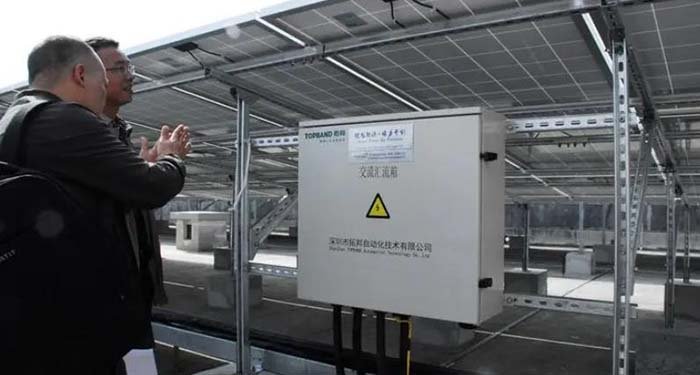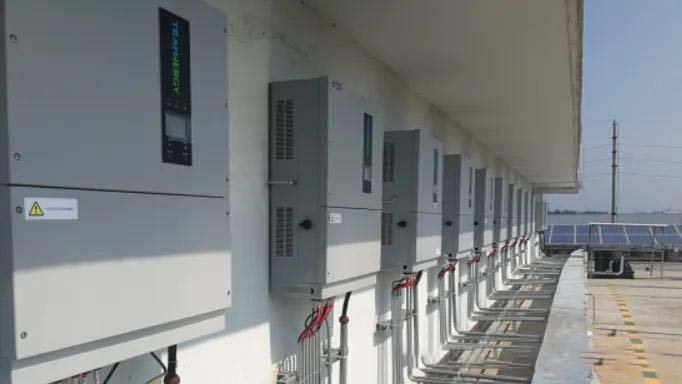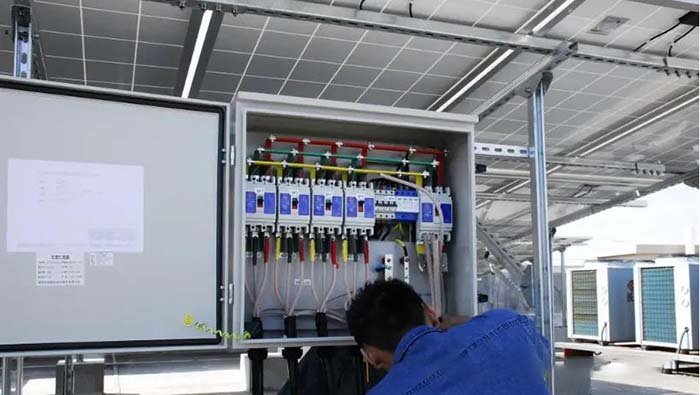What is a PV Combiner Box?
1. What is a PV Combiner Box?
A PV Combiner Box is a critical component in a photovoltaic (PV) power generation system. It collects the output current from multiple PV modules and, through protection and control devices, delivers the current to the inverter for processing. It plays a key role in the PV system by centralizing connections, providing protection, and controlling the flow of electricity, ensuring the system operates efficiently and safely.

Main Functions of a PV Combiner Box
- Combining Function: It aggregates the direct current (DC) output from multiple PV modules (or arrays) and channels it into one or more output lines, reducing the wiring complexity at the inverter’s input.
- Protection Function:
- a) Equipped with DC circuit breakers or fuses to provide current protection for each PV module, preventing a fault in one module from affecting the entire system.
- b) Equipped with surge protectors to guard against lightning strikes and surges.
- c) Equipped with current monitoring and protection devices to prevent overcurrent, short circuits, and other faults.
- Detection and Monitoring Function:
- a) Uses current and voltage sensors to monitor the operational status of each PV module in real time, providing data to the monitoring system.
- b) Equipped with communication modules to transmit data wirelessly or via cable to the monitoring center for remote control and management.
- Simplified Wiring: Reduces the number of cables at the inverter’s input, simplifying system wiring and improving reliability and aesthetics.

Key Components of a PV Combiner Box
- DC Circuit Breakers or Fuses: Protect the current input of each PV module from short circuits or overcurrent.
- Surge Protectors: Shield the system from lightning strikes and surges, ensuring safety.
- Current and Voltage Sensors: Monitor the current and voltage of each PV module in real time, providing data to the monitoring system.
- Combiner Busbar: Connects the positive and negative outputs of each PV module, aggregating the current.
- Enclosure: Made from waterproof, dustproof, and corrosion-resistant materials, ensuring reliable operation in harsh outdoor environments.
- Terminal Blocks: Facilitate the connection of output cables from PV modules and input cables to the inverter.
- Communication Module: Enables communication with the monitoring system for remote data transmission and system management.
Applications: PV combiner boxes are suitable for ground-mounted PV power stations, rooftop PV power stations, and distributed PV systems.
2. Installation and Maintenance of a PV Combiner Box
1. Installation
- Location: Confirm the installation location of the PV combiner box, ensuring it is convenient for cable routing and future maintenance, and that it is far from water sources, dust, and corrosive environments.
- Mounting: Use waterproof, corrosion-resistant bolts and washers to securely fix the combiner box to the installation bracket or foundation.
- Cable Routing and Grounding: Connect the DC output cables from PV modules to the input terminals of the combiner box. Ensure tight connections to avoid poor contact. Connect the output cables from the combiner box to the inverter’s input terminals, ensuring proper routing to avoid crossing and interference. Ground the combiner box reliably according to national and local electrical codes.
- Final Checks: After installation, check all cable connections for correctness and firmness. Test the current and voltage of each PV module to ensure the combiner box is functioning correctly.

2. Maintenance
- Regular Inspections: Regularly inspect the interior and exterior of the combiner box for dust, corrosion, or damage. Check cable connections for firmness and signs of loosening or aging.
- Cleaning: Use a dry, soft cloth to clean the exterior of the combiner box to prevent dust accumulation. If there is dust inside the box, clean it with professional tools after powering off.
- Surge Protection Checks: Inspect the status of surge protectors to ensure they are within their effective lifespan. Replace any damaged or failed surge protectors promptly.
- Current and Voltage Monitoring: Regularly monitor the current and voltage of each PV module, record the data, and compare it with historical data. Investigate and address any anomalies promptly.
- Tightening Checks: Periodically check all bolts and terminal blocks for tightness to prevent loosening.
- Software Updates and Data Backup (if applicable): If the combiner box is equipped with monitoring software or communication modules, regularly check for software updates to ensure stable system operation. Back up monitoring data to prevent data loss.
Proper installation and regular maintenance of the PV combiner box are crucial for ensuring the efficient and safe operation of the PV system. Adhering to standardized installation procedures and scientific maintenance methods can effectively extend the lifespan of the equipment and improve the overall performance of the system. Both installation and maintenance should follow relevant safety protocols to ensure the safety of operators and equipment.


